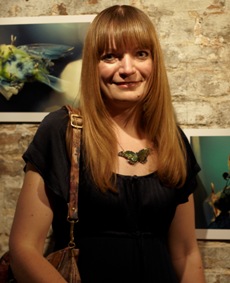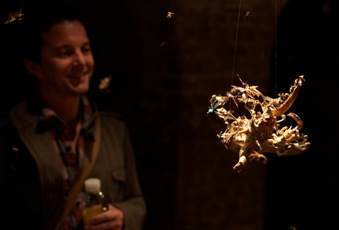Tessa Farmer, Danielle Arnaud Art Gallery/Crypt Gallery | reviews, news & interviews
Tessa Farmer, Danielle Arnaud Art Gallery/Crypt Gallery
Tessa Farmer, Danielle Arnaud Art Gallery/Crypt Gallery
This Saatchi favourite makes art that’s scarily fun but still has gravitas
The world of artist and entomologist Tessa Farmer really is a world, wholly self-contained and free of human kind – unless you see her tiny warring fairies as symbolic of mankind’s conscience-free decimation of our planet’s environment and co-inhabitants. And it’s hard not to when you see them relentlessly picking over the corpse of a bird, mugging a mouse, or scrapping with a hornet, their tiny skeletal forms so industriously yet somehow amusingly destructive.
 Working more as a mischievous Dr Frankenstein or Surrealist taxidermist than as a sculptor, Farmer (pictured right) assembles her pieces from bits of once-living animals, plant roots and insects, rather than actually making them from scratch from more malleable traditional materials. Perhaps this is why they almost glow with presence: they have life because they once were life. They are assemblages of organic matter reanimated and anthropomorphised by Farmer’s sly wit and fertile imagination.
Working more as a mischievous Dr Frankenstein or Surrealist taxidermist than as a sculptor, Farmer (pictured right) assembles her pieces from bits of once-living animals, plant roots and insects, rather than actually making them from scratch from more malleable traditional materials. Perhaps this is why they almost glow with presence: they have life because they once were life. They are assemblages of organic matter reanimated and anthropomorphised by Farmer’s sly wit and fertile imagination.
But what a pleasure it was last week to see her work for the first time in the flesh (so to speak) at two very different venues. In Danielle Arnaud’s beautiful Georgian house gallery in south London, the sun slanted through the windows onto a swarm - or rather, a battle scene - of flies, beetles and butterflies, each individually suspended by almost invisible threads from the ceiling. You could call it an ambient installation if you wished to impose an art-speak definition on it, because although each element is individually tiny, en masse the piece imposes itself on the otherwise almost empty room, forcing nervous viewers to be careful not to collide with it.
In another room hangs a kind of flying boat, all Viking spiky and calibrated for war. Its central armature is an inverted sheep’s jawbone pimped up with crab-claw appendages. Its inhabitants are all manner of creepy crawlies, industriously busy but frozen in the moment by the artist’s obsessive eye. The early evening sunlight bestowed a kind of innocence on these intricate indescribable assemblages of bone, skin, desiccated frogs and… well, you name it. Looking at these scenes of decay, chaos and devastation one almost feels like a faintly amused but redundant god, observing the natural order as if it were just a second-rate game show landed upon while channel-hopping.
So what could be more edifying than seeing Tessa Farmer’s work in a series of sun-lit rooms in Kennington? Obviously the answer is seeing them in semi-darkness in the claustrophobic crypt of a church with some spooky music playing in the background. The spooky music was provided by Brazilian electronica musician Amon Tobin who is Farmer’s collaborator on ISAM: Control Over Nature. But if I’m to be honest, it could have been any vaguely sinister, somewhat Eno-esque music rumbling and throbbing away in the background. Although Farmer’s work is featured on the cover of Tobin’s CD, it was Farmer who did her work in response to his, rather than the other way around. And it’s her installations which arguably created the buzz on the opening night.
One track on the album, a glitchy, itchy nursery-rhyme-from-hell entitled “Kitty Cat”, inspired the centre piece of the Crypt show. In a small windowless cell a mummified cat lies on a black square plinth, starkly lit from above. One’s first queasy thought is of the operating table, but as always with Farmer’s work, your response changes as you move in closer. The cat corpse becomes a landscape which then becomes a Gaudí-esque playground/prison camp for the myriad bees, hornets, wasps and those ubiquitous fairies to live, fight and build on.
But as much fun as all this is, the question eventually has to arise as to whether it’s art or not. Given the expressions of wonder, amusement, fascination and sheer uncomplicated enjoyment of the visitors at both exhibitions (see picture below) you might suspect the answer to be no: how could art be this creepy and this much fun? Surely art is supposed to be tough and only reward the fully initiated? Well, I beg to differ, although given that Saatchi is a patron and she’s currently one of the UK’s fastest rising artists, I’m not the first witness for the defence. The best art is about altering perceptions, utilising skills and harnessing and channelling an imaginative vision. Farmer is essentially a romantic in the grandest, weightiest, weirdest sense of the word.
 Although in possession of an MA in Fine Art, Farmer is like an outsider artist in her obsessive immersion in detail and her apparent lack of interest in where she stands in relation to her contemporaries. In her work can be seen echoes of everything from Dalí's vulgar rococo extravagances, to death-obsessed, symbol-rich Dutch still-life paintings of the 17th century. She is the very antithesis of celebrity artists like Tracey Emin who with their blinkered egotism insist on pursuing the almost century-old Duchampian notion that the gesture and the gesture’s context are everything. Farmer represents a move away from wilful exclusivity back to an art where you don’t need to have read the catalogue essay to fully grasp what’s going on. So, yes, long may creepy-crawlies continue to die so they can be reborn as part of one of her blackly comic fantasias.
Although in possession of an MA in Fine Art, Farmer is like an outsider artist in her obsessive immersion in detail and her apparent lack of interest in where she stands in relation to her contemporaries. In her work can be seen echoes of everything from Dalí's vulgar rococo extravagances, to death-obsessed, symbol-rich Dutch still-life paintings of the 17th century. She is the very antithesis of celebrity artists like Tracey Emin who with their blinkered egotism insist on pursuing the almost century-old Duchampian notion that the gesture and the gesture’s context are everything. Farmer represents a move away from wilful exclusivity back to an art where you don’t need to have read the catalogue essay to fully grasp what’s going on. So, yes, long may creepy-crawlies continue to die so they can be reborn as part of one of her blackly comic fantasias.
- Tessa Farmer: Nymphidia at the Danielle Arnaud Gallery until 26 June
- Tessa Farmer + Amon Tobin: ISAM Control Over Nature at the Crypt Gallery until 5 June
 Find Amon Tobin on Amazon
Find Amon Tobin on Amazon

Add comment